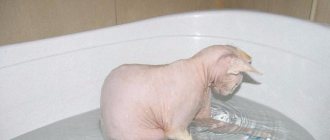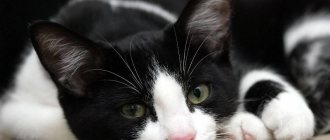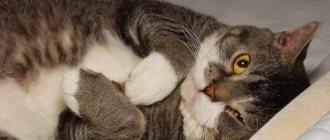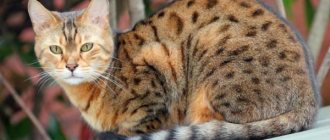Origin of the breed
These cats originally appeared on the islands of the Aegean Sea. The breed appeared independently in nature and is widespread mainly in Greece.
Wild representatives of the Aegean breed still live on the islands. There they feed on fish, which they themselves catch in the sea. The cat was brought to the mainland by sailors. So it spread throughout Greece.
Scientists paid attention to this breed in the 90s of the last century. At the same time, Greek breeders began breeding it. A purebred Aegean cat is very difficult to buy or even just see outside its native country. It is not common in Russia because of its color. You cannot buy such a cat in Russia, because no one breeds them.
Origin story
Many sources indicate that Aegean cats originate from the island of Tsikladis.
However, this is not true, since there are no islands with this name in the Aegean Sea, unlike the Cyclades islands, which form the Aegean archipelago. In total, the Cyclades includes about 220 islands. It was on them that the formation of a group of Aegean cats took place, which constantly traveled with fishermen from one island to another. For centuries they lived in various ports and with ordinary citizens, so they are considered one of the most ancient aboriginal cat breeds. Their targeted breeding began in the 1990s. The Greek Feline Association submitted an application to the WCF and received a positive decision to classify Greek cats as a separate breed.
The breed's homeland is the Greek Cyclades or the Cyclades Islands in the Aegean Sea. For hundreds of years, these wild cats lived there in the fishing ports, begging for a tasty morsel. So they were tamed. The pets sailed to mainland Greece together with one of the fishermen. There these cats became famous as excellent hunters and killers of rats and mice.
But the targeted breeding of the Aegean cat as a separate breed began only in the 1990s by a few Greek breeders. The breed is not yet officially recognized and is considered quite rare outside of Greece.
Main features
Usually, purebred cats require exceptional care and guardianship from their owners, and these sissies rarely go outside, spending their lives in the house, lazily lying down and touching their owners. The Aegean cat will not be able to sit at home all the time. She needs space and fresh air. These cats require no more care than purebred cats.
Unlike most cats, Aegean cats are not only not afraid of water, but also love to bathe and swim. Washing her will be no more difficult than washing a child.
The favorite food of Aegean cats is fish. They faithfully wait on the shore for their fishermen owners with prey, and sometimes they can bring it themselves.
Description of the breed
In appearance, this cat is indistinguishable from ten dozen outbred cats running around our streets: white cats with dark spots - bicolor and tricolor. Here you have strict white and black, and playful white and red (red), and sophisticated white and blue. Perhaps the most common is white with tabby patterns of various colors. But!
- There is always more white than color, the approximate proportions are 1 to 2 or 3 times!
- White is never yellowish or grayish, only white-white, like the first snow that fell on a frosty morning - two!
- A pure white cat, without spots at all - no longer an Aegean cat, but some other cat - three!
- The eye color of the Aegean cat is exclusively green with various shades and never falls into the color of the spots (that is, a cat with red spots should not have copper or yellow eyes) - four!
- Genetics have proven that the Aegean cat was formed in the course of natural formation (aboriginal breed) - five!
- And this aboriginal is one of the oldest representatives of domesticated cats - six!
- The Aegean cat is the national pride and heritage of Greece, because is the only “native” cat for this state - seven!
Not a bad track record! But this is not the end of the story about the Greek cat.
Photo with Aegean cat
1 of 30
Where can I buy it?
Outside of their native Greece, Aegean cats are not particularly popular. Many breeders and those wishing to have a kitten believe that these cats have ordinary, not particularly attractive, external characteristics. The cost of a kitten varies from 10 to 35 thousand rubles, depending on gender, appearance and pedigree.
At the same time, be sure to study the reviews about the seller and do not forget to take into account the additional costs of transporting your future pet.
Only a few breeders in Greece are involved in breeding Aegean cats, therefore, purebred kittens can only be bought there. Outside the homeland, breeding this breed is considered not a profitable activity. They very much resemble ordinary yard cats. Nevertheless, foreign breeders are more interested in the breed than the Greeks themselves. Native cats are relatively inexpensive.
Many breeders consider breeding these animals unprofitable, so you can only buy an Aegean cat in its homeland in Greece or the Cyclades Islands.
We suggest you read: What to do if your cat has a tumor in the ear
The price of an Aegean cat varies from 10 to 20 five thousand rubles. The cost of a baby of this breed depends on appearance, gender and pedigree, and the final price is set only by the breeder.
Proud and independent, but at the same time affectionate and devoted, the Aegean cat will become a wonderful pet for any person and will bring only positive and bright emotions into the life of its owner.
Video
Sources
Appearance
Aegean cats look very similar to ordinary yard cats.
The coat color combines several colors. The main color is white. Additional colors are black, cream, red, blue, gray and brown. There can be two or one additional colors. Most often, colored ears, paws, back, head and tail. There is usually two or three times more white in color than the others.
Eyes can be any shade from yellow to green. They are large, oval in shape and their outer corners are raised up. The head is triangular in shape, the muzzle is elongated, and the nose is straight.
These cats are medium-sized, strong and robust. The body has an elongated shape, the legs are long and large. The coat does not have a dense undercoat, but cats still do not freeze in the cold season. It has medium length and fluffiness.
Breed standard
The experimental breed standard gives the following description of the Aegean cat.
Head
In the form of a medium-sized modified wedge. Set on a strong and muscular neck. The chin and cheekbones are clearly defined, and the whisker pads are well defined. The forehead is straight, the crown has a slightly pointed shape. The entire head consists of slightly smoothed corners.
Eyes
Small or medium, in the shape of tonsils. The color corresponds to the color, but more often in green shades - from olive to rich emerald. Yellow, amber, and topaz colors are acceptable.
Medium size, widely spaced. They become very sharp towards the ends. They have abundant furring inside.
Strong, lean, with strong bones and a wide back. The muscles are developed.
Long, strong, proportional, with lean and strong muscles. The pads are round and strong. They have extremely sharp and durable claws.
Tail
Long, proportional to the body. The fur on it is slightly longer than on the body. Straight and smooth, defects such as knots and kinks are unacceptable.
Wool
This is a short-haired breed, but the hair is quite long, especially in the neck, tail and hind legs. There is practically no undercoat. The cover is thick, slightly fluffy and very smooth to the touch. Like many breeds living on the shore, it has excellent water-repellent properties.
Colors
They are varied, but most consist of two or three colors (typical for females). Most of the body is white, it is very clean, without signs of yellowness. The second and third colors are red, cream, black, blue and silver, these spots are located on the head, back and tail. Tabby and tortie designs are possible. The presence of snow in color is a prerequisite.
This animal is small to medium in size, weighing from 3 to 5 kg. Dimorphism is inherent in this breed - males are slightly larger than females.
Character of Aegean cats
These cats are active and playful; they cannot sit in one place. They love to hunt, perfectly protect the house from rodents, but they pose a danger to small pets.
They are very smart, understanding, love communication and affection, but do not impose themselves. Children are treated patiently and do not scratch. Aegean cats love and try to protect small family members. They are not subject to training.
Aegean cats are as loyal to their owners as dogs, but they are not jealous and easily share affection with other pets and people.
If you talk to this cat, she will answer, in her cat language of course. They love it.
Cats will not tear up wallpaper and furniture, dirty everything around them and ignore the comments of their owners. They are not inclined to misbehave and disobey.
Cats love to be outside, running and playing in the fresh air. Sitting constantly in a house or apartment, they will feel bad and sad. For this cat, the best option would be a private home. If she lives in an apartment, then, if possible, the cat should be allowed to go outside at her own request or be walked daily for a long time, preferably without a leash.
Conditions of detention
When getting an Aegean cat, you should understand that it needs complete freedom. For example, a private home is perfect for representatives of this breed, where the animal can freely spend time outside.
Cats living in an apartment will benefit from regular and long walks. They will improve your pet's health and make him feel great. Otherwise, the animal will feel sad and depressed, which will not have the best effect on its physical condition.
Aegeans adapt well to a new place in the shortest possible time. They need affection and attention from their owners. In order for cats to feel cozy and comfortable and delight their owners with their beauty and health, it is necessary to know their character and provide them with proper care and concern.
Photo from the Aegean cat page
Caring for Aegean cats
Mandatory care for cats of this breed consists of several mandatory procedures:
- Vaccinations and vitamins;
- Combing fur during shedding;
- Bathing;
- Feeding;
- Treatment as needed.
Like ordinary cats, Aegean cats develop various parasites, and their ears and eyes become inflamed. They catch colds and get injured. Treatment of all these diseases is carried out by a veterinarian and does not require special rare medications. Prevention can be carried out with ordinary antiparasitic drugs, vitamins and good nutrition.
During shedding, the fur should be combed once a day with a wide comb or a special soft brush so that the fur does not gather in clumps and lie all over the house. At normal times, it is not necessary to brush your cat.
You need to bathe an Aegean cat just like a regular cat, if necessary or desired. It does not require mandatory washing. These cats like to bathe, so you can do this to please the animal.
A cat's diet must include fish. This is their common food in the wild and is essential for Aegean cats' health and development. In addition to fish, Aegean cats can eat special dry food and homemade food. It is undesirable to feed your cat very salty, spicy and sweet foods. An unbalanced diet can lead to brittle bones and lack of muscle elasticity, affecting the cat's appearance and activity.
Aegean cats do not have genetic diseases or predisposition to them.
The average lifespan of such a cat is 10 - 15 years.
Character
The character of cats is very lively, they are temperamental. These are active animals that are constantly busy and do not like to sit still. Such a cat will not become a plush sofa cushion. They are excellent hunters, and some of them can catch fish well, putting their paws into a pond without fear.
The friendly and peaceful Aegean cat will quickly find a common language with other animals. She is self-confident and not jealous, so she will easily share her owner’s attention with someone else. Small rodents and birds do not count; they can become easy prey. The Aegean will certainly show particular interest in an aquarium with fish.
Aegean cats, as a rule, are very attached to the family, but they choose only one person as the owner. They try to be on an equal footing with the rest. They are unobtrusive, self-sufficient and easily tolerate loneliness.
They treat strangers with caution, but quite peacefully. They usually get along well with children.
These cats are very smart, but because of their pride and independence, they are practically impossible to train. But they agree to a peaceful existence and follow house rules.
Features of care
The short hair of these cats only needs to be brushed once a week. You need to brush your teeth at least three times a week, and trim your claws every 10 days. Although, if you live in a private home and welcome your pet’s desire to catch mice and fish, you don’t have to trim the claws. The furniture will remain intact, as the pet will sharpen its claws on the trees. Be sure to keep your ears and eyes clean; bathing can be done once every few months.
You might be interested in: Description of the breed Scottish Straight cat (Scottish Straight)
History of the breed
The Aegean Sea contains many islands that preserve monuments of ancient Greek and Byzantine cultures. On one of them, on Tsikladis, this cat breed once originated. These cats, which the locals did not pay much attention to, lived there with them for many centuries.
The main occupation of the local residents was, of course, fishing. People regularly left their homes for a long time, and then the furry animals looked after the houses. They caught rodents that arrived here on ships with goods, and people paid them with tolerant treatment and shared the fish they caught with them.
These creatures underwent all stages of natural selection at the beginning of their history. Indeed, in those days, when even pneumonia was incurable, people had no time for breeding cats, caring for them and treating them.
Harsh climatic conditions, rough seas, temperature fluctuations and low tides reduced the catch and forced starvation. And infection with bacteria and viruses finished off weakened animals, strengthening the gene pool of Aegean cats.
Probably, the ordinary life of the island cats would never have become known to the world if they had not one day met the right people. They were not noticed, as one might think, by famous felinologists or veterinarians.
These creatures were seen by scientists studying the history of the island of Cyclades. Then the field reports of this team of researchers ended up at the institute. These notes were published there. And then a detailed overview of the habits of these cats caught the eye of cat lovers and interested them. By the way, among the characteristics of the appearance, there were no remarkable features. The exterior of the Aegean cat breed is very ordinary.
What is curious is that although research on the design of the Egean standard started back in the 90s of the last century, the ordinary appearance of these animals still leaves them in the trial category.
The refusal to officially recognize Aegean cats may be due to several factors. They look quite ordinary, which makes it difficult to form a standard. It is enough to be on the street and carefully look at the yard cats, and you will certainly find a creature that fits the standard.
Therefore, the question arises: why buy an individual that can be found for nothing. However, it must be taken into account that the main characteristic of Egeeks is not the exterior, but the character and habits inherited by the kittens of this breed.
The fact that these cats are not recognized, of course, does not lead to widespread fame for others. The number of breeders in all countries hardly exceeds a dozen. Because of this, Aegean cats are not often seen. However, on the Greek island of Tsikladis they are not rare and not at all expensive.
There, in their homeland, these animals live peacefully and their numbers are steadily growing every year. It can be assumed that the finest hour of this breed simply has not yet come. And perhaps soon these intellectually well-developed creatures will conquer the whole world.
Features of the animal's diet
The Aegean cat loves fish. He inherited his love for this dish from his ancestors, who ate mainly only fish. But this product should not be the basis of the diet of these cats. You can pamper yourself with fish twice a week. The rest of the time, the animal’s diet should consist of balanced food (you can use ready-made dry food). The animal can be given cereals, vegetables, and meat. Spicy, salty, fatty or sweet foods should be excluded.
If something is wrong with the animal, the reason is most likely due to poor nutrition. Therefore, at the first signs of illness, you should immediately review your diet.











